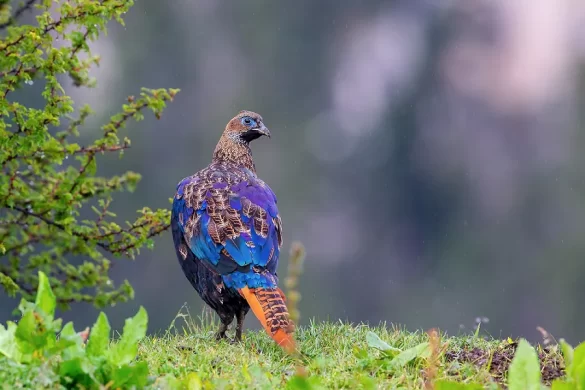The Himalayan Monal (Lophophorus impejanus) is a stunning bird native to the mountainous regions of the Himalayas, including Bhutan, India, Nepal, and Tibet. Known for its vibrant and iridescent plumage, the Himalayan Monal has captured the attention of nature enthusiasts and researchers alike. In order to understand the life cycle and behavior of this magnificent bird, it is essential to delve into its dietary habits. This article aims to uncover what the Himalayan Monal eats and shed light on its feeding preferences.
Overview of the Himalayan Monal’s Diet:
The Himalayan Monal is an omnivorous bird with a diverse diet that varies depending on the season and availability of food sources. It primarily feeds on plant matter, including leaves, buds, fruits, seeds, and flowers. Additionally, it incorporates various invertebrates, such as insects, worms, and snails, into its diet. The ability to adapt its feeding habits allows the Himalayan Monal to survive in different habitats throughout its range.
Plant Matter in the Diet:
During the summer and monsoon seasons when vegetation is abundant, the Himalayan Monal predominantly consumes plant matter. Its diet consists of a wide range of plant materials, including grasses, ferns, herbs, and shrubs. They feed on leaves and tender shoots, providing them with essential nutrients and hydration. Fruits and berries also form an important part of their diet during the summer months when these resources are readily available. Some examples of fruits consumed by the Himalayan Monal include wild strawberries, raspberries, and juniper berries.
Feeding Preferences:
While the Himalayan Monal demonstrates a generalist feeding behavior, it does exhibit certain preferences when it comes to selecting its food. Research suggests that they show a preference for certain plant species, such as Polygonatum spp. (Solomon’s seal), Primula denticulata (drumstick primrose), and Hippophae rhamnoides (sea buckthorn). These plants provide a rich source of nutrients and are often selected over other available options. Such preferences may be influenced by factors such as taste, nutritional value, or the presence of specific compounds that benefit their health.
Invertebrates in the Diet:
Although primarily herbivorous, the Himalayan Monal also incorporates invertebrates into its diet during different stages of its life cycle. Insects, worms, and snails are an important source of protein, especially during the breeding season when the demand for energy is high. They actively forage on the ground, flipping leaves and probing the soil to find hidden invertebrates. This opportunistic feeding behavior allows them to exploit available resources and meet their nutritional requirements.
Feeding Ecology:
The Himalayan Monal’s feeding habits play a crucial role in shaping its ecology and influencing the ecosystems it inhabits. As they consume various plant materials, including seeds and fruits, the bird aids in seed dispersal, promoting forest regeneration and maintaining plant diversity. Additionally, by consuming invertebrates, they help control insect populations, contributing to the balance of local ecosystems.
Seasonal Variation in Diet:
The Himalayan Monal adapts its diet according to seasonal changes in food availability. During the harsh winter months when vegetation is scarce, they rely heavily on underground storage organs like bulbs and tubers. These underground parts serve as a critical food source during periods of snow cover or freezing temperatures when accessing above-ground plant material becomes challenging.
Conclusion:
The dietary habits of the Himalayan Monal reveal its versatility and adaptability as a mountain bird. With a diverse diet consisting of plant matter and invertebrates, this colorful species has carved out a niche for itself in the challenging Himalayan ecosystem. By consuming a variety of food sources, the Himalayan Monal contributes to important ecological functions such as seed dispersal and insect control. Further research on its dietary preferences and feeding behavior will enhance our understanding of this magnificent bird and aid in its conservation efforts across its range.


 Facebook
Facebook  Instagram
Instagram  Youtube
Youtube 